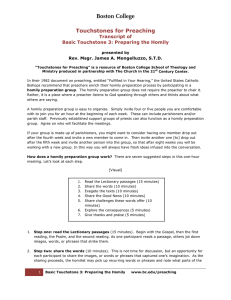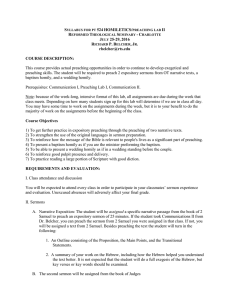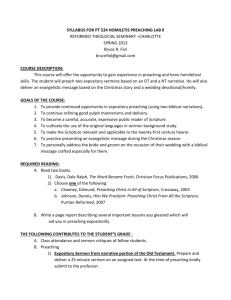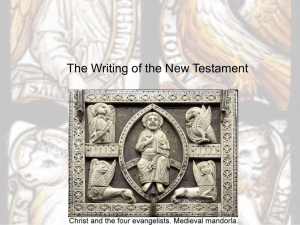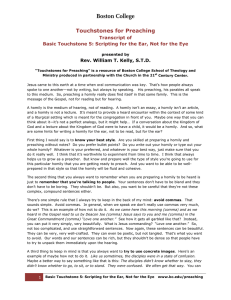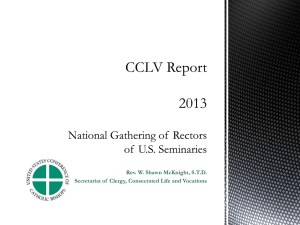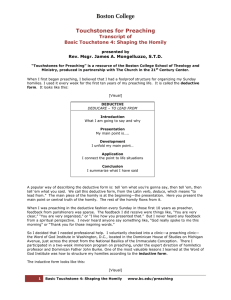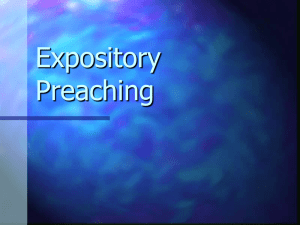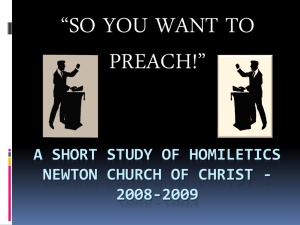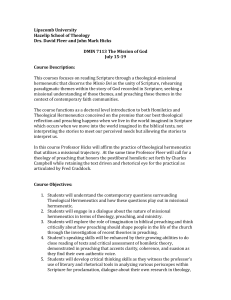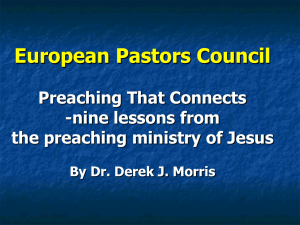Preaching the Mystery of Faith: The Sunday Homily
advertisement
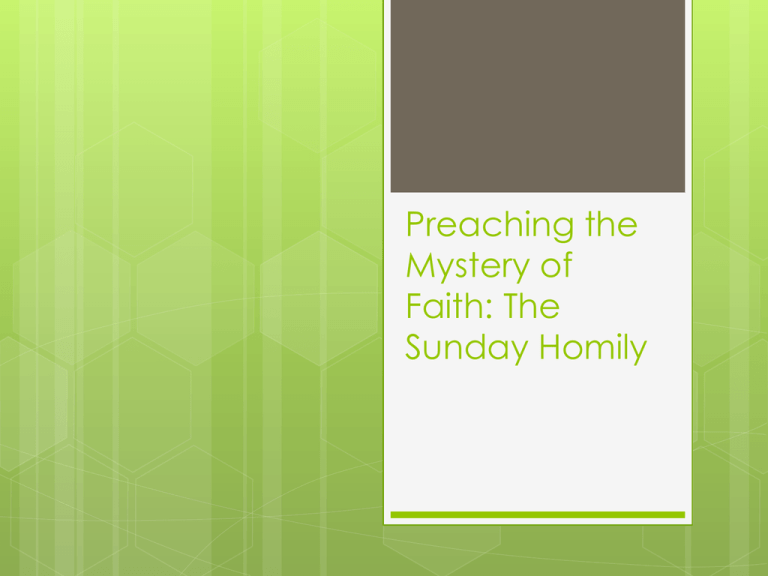
Preaching the Mystery of Faith: The Sunday Homily Fr. John Guthrie Associate Director, Secretariat of Clergy, Consecrated Life and Vocations USCCB PowerPoint found at: www.usccb.org/priesthood Two Talks: Exploration of the Document Magisterial foundations Contents of the Document Comparison with “Fulfilled in Your Hearing” (1982) Practical Pastoral Implications Some strategies and resources Case study Magisterial Foundations: Dei Verbum God self-communicates A personalist view of revelation Pope Benedict XVI “Balance” Exegetical approach Promotion of “theological exegesis” leading to “theological homilies” Preaching the Mystery of Faith The context: the New Evangelization which is the “focus, mission, and ministry of the Church going into the future” (p. 3) The challenge: “the homilist of today must realize that he is addressing a congregation that is more culturally diverse than previously, one that is profoundly affected by the surrounding secular agenda and, in many instances, inadequately catechized” (p. 5) Objectives “To stir the hearts of our people” (p. 4) “To deepen the knowledge of the faith” (p. 4) “To renew their living the faith in the world and participation in the Church and her sacraments” (p. 4) “To lead people into a loving and intimate relationship with the Lord” (p. 26) “To lead the hearer into the deep inner connection between God’s Word and the actual circumstances of one’s everyday life” (p. 29) “To inspire and move those who hear it, to enable them to understand in heart and mind what the mysteries of our redemption mean for our lives and how they might call us to repentance and change” (p. 30) The integrative role of the homily—Insights from the Emmaus Story Heading away from Jerusalem and the Introductory Rite “The Paschal Mystery informs Human Experience” Old and New Testament illumine one another = the Liturgy of the Word Homily links Scripture and Eucharist = Liturgy of the Eucharist “The Emmaus account illuminates the interpenetration of the two dimensions of the Eucharistic liturgy. Jesus’ explanation of the Scriptures (the Liturgy of the Word) leads to an intense experience of communion with the Risen Christ (the Liturgy of the Eucharist), and the very vividness of the latter bring about a deeper appreciation of the former (‘Were not our hearts burning within us?’)” (p. 17) Sending on mission = Concluding Rite “Our encounter with Jesus inevitably leads to mission; our love for Jesus translates into love for others. This is why the homily … ought to inspire a sense of mission for those who hear it, making them doers and proclaimers of the same word in the world. A homily that does not lead to mission is, therefore, incomplete.” (p. 18) The new and key section of document: "The Sunday Homily, Doctrine, and the Church's Catechesis" (pp. 21-27) “the intrinsic relationship between preaching, doctrine, and catechesis” (p. 21)— example: St. Paul’s preaching A balanced approach and the place for theological homilies “The Church’s rich theological, doctrinal, and catechetical tradition must therefore properly inform the preaching task in its liturgical setting” (p. 5) Comparison with Fulfilled in Your Hearing (FYH) (1982) Fr. Jeremy Driscoll, OSB: “Nothing is lost here…. But much is gained” Continuity Explicit Affirmation of FYH Theology of the Preacher Affirmation of importance of images, metaphors and stories Discontinuity (shades of difference) PMF: a statement of the whole Conference Humility vs. confidence Starting point Assessment of the culture, surrounding environment View of historical-critical method Reflection Questions: What do you find affirming about the new document, Preaching the Mystery of Faith? What do you find challenging? How does the insights of the document affirm your own preaching? How do they challenge it? Practical Pastoral Implications “The Church’s rich theological, doctrinal, and catechetical tradition must therefore properly inform the preaching task in its liturgical setting” (p. 5) How can catechesis and doctrine “inform” the preaching task? Theological Tools: A good Catholic commentary such as the “Catholic Commentary on Sacred Scripture” Fr. Daniel Merz and Marcel Rooney, OSB: Essential Presidential Prayers and Texts (Liturgical Training Publications, 2011) Catechism of the Catholic Church Ancient Christian Commentary on Scripture (InterVarsity Press) Good Catholic theology Sample Homily Structure: Experience Reflection on experience Enlightenment from Scripture Admonition to change = conversion Sample Homily (revised) Structure: Experience Reflection on experience Enlightenment from Scripture Theological Section Admonition to change = conversion Sample Homily: Possible Theological Improvements Catholic Commentary on Sacred Scripture “Drink the cup” “Baptism” On the Lord’s right and left Mass parts for 29th Sunday in Ordinary Time: Collect: “Almighty ever-living God, grant that we may always conform our will to yours and serve your majesty in sincerity of heart.” Prayer over the Offerings: “Grant us, Lord, we pray, a sincere respect for your gifts, that, through the purifying action of your grace, we may be cleansed by the very mysteries we serve.” Prayer after Communion: “Grant, O Lord, we pray, that, benefiting from participation in heavenly things, we may be helped by what you give in this present age and prepared for the gifts that are eternal.” Catechism Church 605 1551 1570 of the Catholic Good Catholic theology Fr. Jeremy Driscoll, OSB Creed: “For us men and for our salvation” ”Jesus is Lord” Fr. Robert Barron Incarnation … kenosis Online resource: usccb.org/homiletics Process: Evaluate a recent homily: what are the possibilities of making it more catechetical/theological?
